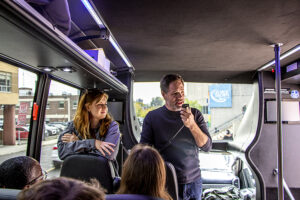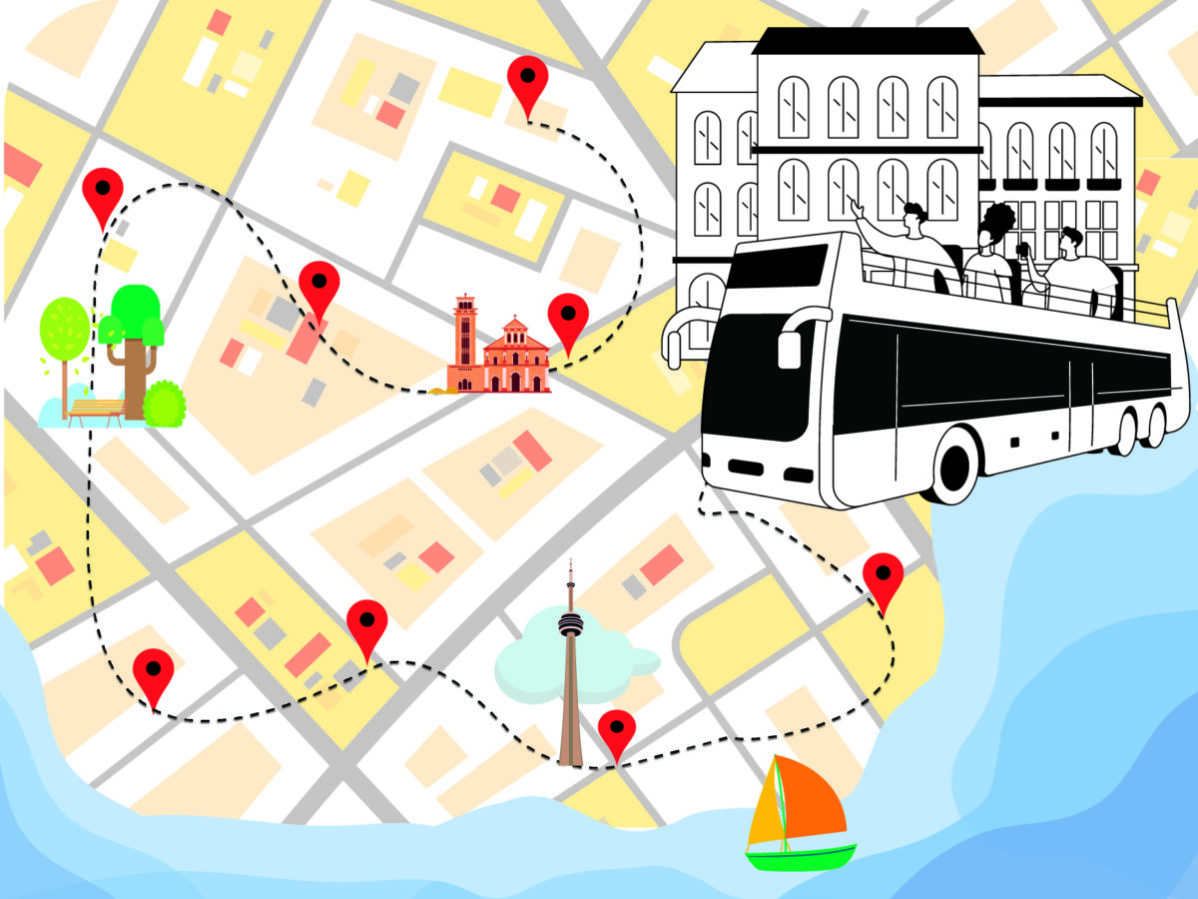GBC’s Indigenous Initiatives took staff and students on a historic tour around the city.
During their latest event, the goal of the Indigenous Initiatives team of George Brown College (GBC) was to teach the stories of the city.
The First Story bus tour took place Oct. 6, taking participants through major indigenous landmarks and areas of significance, to explore Toronto’s indigenous history.
The event was facilitated by First Story Toronto, a community-based organization that shares Toronto’s indigenous history and presence through education initiatives.
Participants included students, staff, and faculty members, who took part in the discussions led by the bus tour facilitators and speakers, Teagan de Laronde and Jon Johnson.
“A lot of what’s the colonial landscape is, in some ways, an attempt to erase indigenous presence, but it also inadvertently encodes that practice… as one of the prominent landmarks in the city is built on top of the original landmarks. So, you can kind of read the colonial architecture a little bit against the grain, and you can kind of see what’s you know, the stories and the longer history,” said Johnson during the tour.

Teagan de Laronde and Jon Johnson guided staff and students of GBC on a tour around Toronto. Photo by: Ayeshwini Lama
As the tour group stopped for a stroll in High Park, they examined the remaining black oak trees and discussed the various medicinal plant knowledge that comes from the indigenous community.
Indigenous culture has a strong connection to nature and land, some examples of which are the variety of medicinal plants found around high park and also a few burial mounds.
The burial mounds, once supposed to remain untouched, now remain unmarked and are climbed by photographers and the public for pictures and other activities.
“This entire place is without a single place so far that hasn’t been touched by the legacy of indigenous footprints,” Johnson said, emphasizing that the city is still full of spiritual places and presence. “There’s always opportunity whether you are an urban, indigenous person or you are more like, focused on or oriented toward the reserves, or the more rural space, there’s always opportunity.”
The facilitators of the tour bus added that indigenous teachings and history can teach us how to relate to other beings in our surrounding, and that is is important to keep these teachings alive.
“There’s always a lesson in something. There’s always a teaching or a lesson or something is supposed to get like if you’ve noticed, something keeps coming up for you, like maybe a certain animal or a certain word or something. And it’s something that you’re supposed to reflect on. And, like just pay more attention to, because it’s actually trying to teach you something,” said Colleen Kettle, a participant on the bus tour and a student at GBC’s Assaulted Women’s and Children’s Counsellor/Advocate program.
The bus tour started at the GBC Casa Loma Campus and went through the following places:
Spadina:
The name Spadina comes from the Anishinaabemowin word “ishpadinaa” which means ‘high hill.’ The elevated plateau allowed the indigenous people to see any incoming danger.
The name was given to the ancient trail somewhere along the current Spadina Road. The street signs at the intersection of Spadina and Davenport honour that.
Davenport Road:
Davenport Road, which was once the shoreline of Lake Ontario, was an important trade and travel route for many Indigenous peoples and communities.
It was originally known as Gete-Onigaming; which is Ojibwe for ‘at the old portage.’
Garrison Creek:
Garrison Creek is an underground river that lives as a sewer system today through St. Clair Avenue West. The creek was covered up during the mid-20s due to rising pollution of the river with increased population.
River systems and all natural things hold significance in the indigenous community and therefore an unnatural state of a river such as this causes concern.
Baby Point:
The plateau overlooking the Humber River was once the village of Teiaiagon occupied by the members of Seneca nation. The area consisted of houses which could provide shelter to more than 500 people. The plateau gave the people a good vantage point to see any incoming dangers.
Today, the place is known as Baby point, after James Baby who was a prominent French-Canadian merchant and an early resident of the Town of York.
Humber River:
There are two indigenous names for this river. The Anishinaabe name is Cobechenonk and the Haudenosaunee name is ‘Niwa’ah Onega’gaih’ih’ or “Little Thundering Waters.” It is believed that this refers to the presence of thunder beings, who are responsible for the rain and protecting the land.
High Park:
What we now call as High Park was inhabited and traveled by many Indigenous people in the past. Many different first nations cultivated areas known as Black Oak Savannah through fire and controlled burns, remains of which can still be seen today.
These savannahs helped improve the health of both humans and the ecosystems. This practice helped activate the oaks and other species of plants that would grow better in the aftermath of the burning.

The tour group got out to explore and learn in some of the highlighted spots. Photo by: Ayeshwini Lama.
Lake Shore and Lake Ontario:
In 1908, 11,000-year-old footprints were found while building a waterworks tunnel somewhere along the lakeshore. Unfortunately, the prints which could have been a historic discovery of footprints of the first people of Ontario, were not preserved.
The name for Lake Ontario itself comes from a native word Oniatarí:io and means ‘good looking lake’ or ‘lake of shining waters.’ The Toronto Islands, which are situated on the lake, are an important place, especially for the Mississaugas, who use it as a primary place of worship.
Jarvis Street:
The street was named after Samuel Jarvis, who inherited a large portion of land in the area from his father, who had been granted all that land free of charge. Samuel Jarvis was the chief superintendent of Indian Affairs for Upper Canada until he was forced to resign in disgrace for embezzlement.
Jarvis had to sell the land, and the road he built for the buyers to reach their new property was named after him.
CN Tower:
The CN tower is built on land that was reclaimed from Lake Ontario, whose shores and waters were a meeting place for many first nations peoples.
The First Story bus tour for GBC family was organized by Indigenous Initiatives of GBC
More information on events can be found at www.georgebrown.ca/indigenous.


